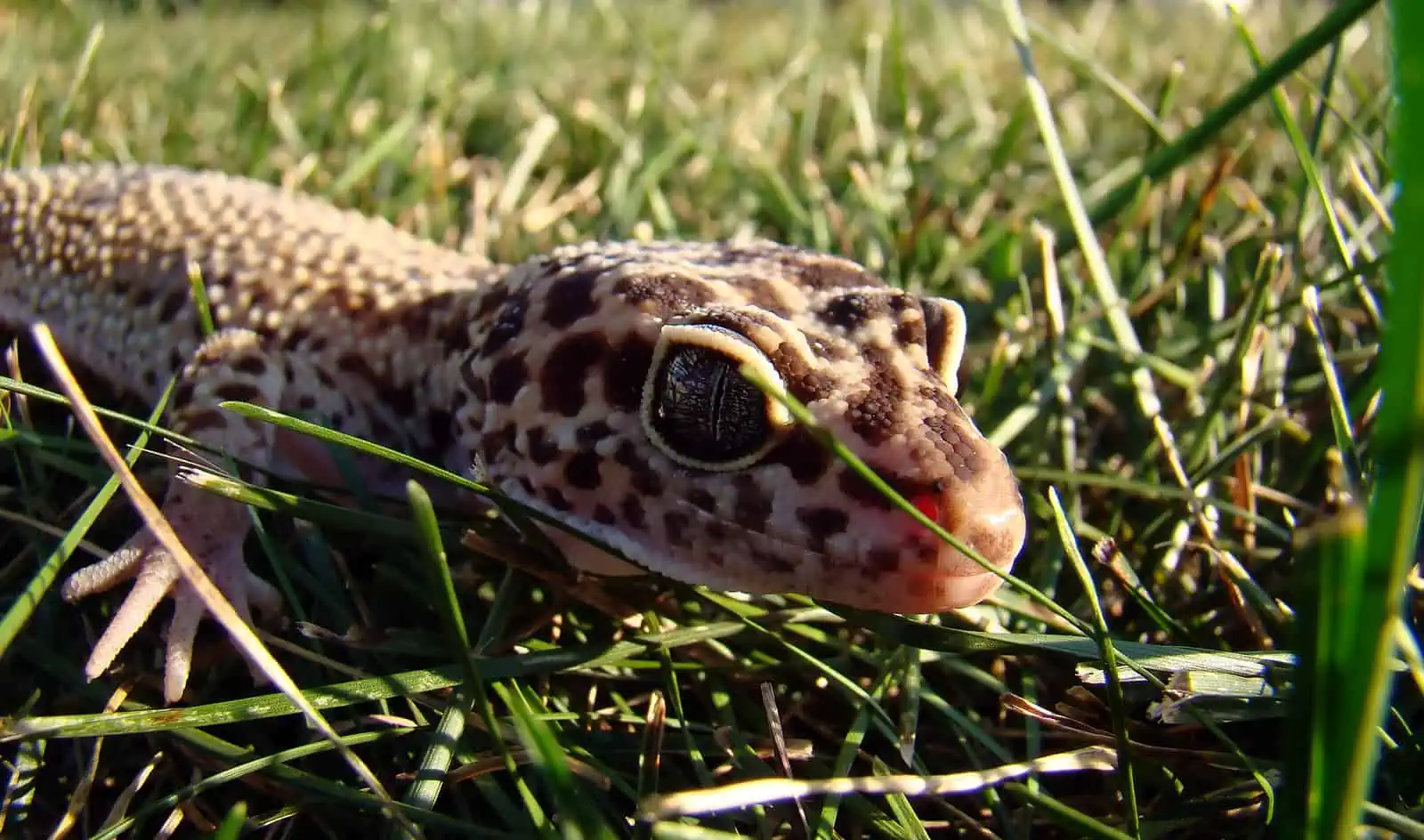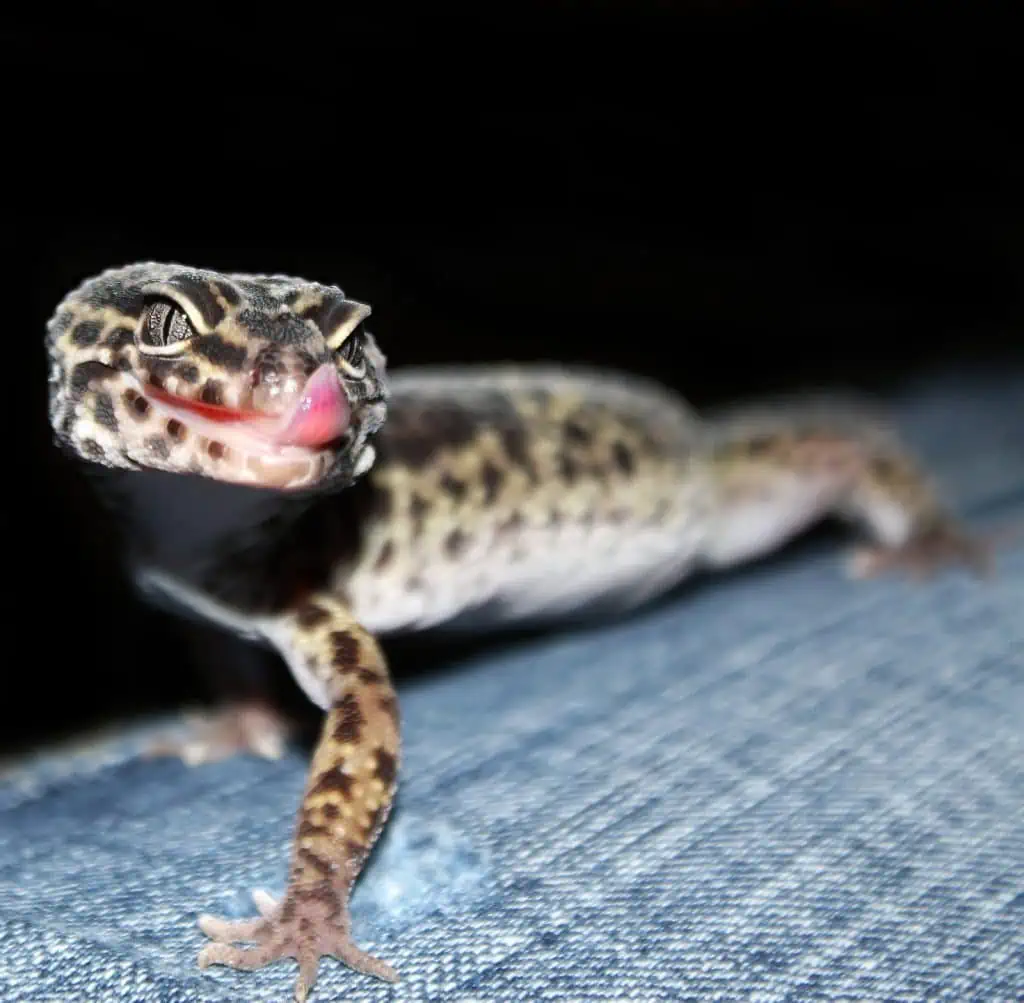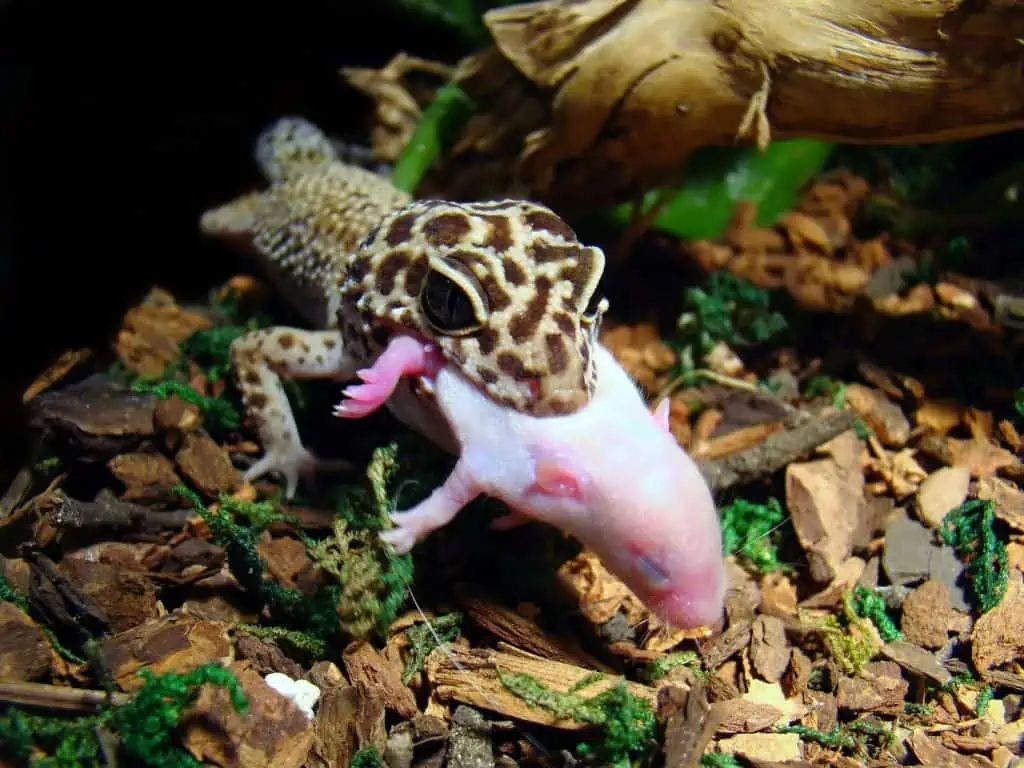Leopard geckos are so easy to feed, at least as far as reptiles go.
Once they’re established at their new home, average leos will accept most, if not all, common feeder insects with hefty appetites.
In fact, leos can be too easy to feed. The appetites of some individuals are big, so they will eat whenever you offer them food. If the offer is too frequent or fatty, it can lead to excessive weight and obesity.
Lack of information and unhealthy myths surrounding leopard gecko nutrition have contributed to a trend of overweight leopard geckos.
How to keep your leopard gecko fit, and what to do if he gets too plump?
Let’s answer that.
Overweight vs. Obesity
The World Health Organization defines overweight and obesity as “abnormal or excessive fat accumulation that presents a risk to health.”
Although this is a human and not a gecko health institution, the same applies. Leos with excessive fat are overweight at first and obese later.
As we’ll shortly learn, being overweight and obese can lead a leopard gecko to many health issues sooner or later.
What is Leopard Gecko Normal Weight?
The normal weight of adult leopard gecko males is 60-90 grams.
Females can be much lighter – 45 grams and above.
However, depending on their genetics, size, and build, each leopard gecko has its own normal weight. One leopard gecko may be perfectly fit at 90 grams or even more, but another one will be overweight at the same weight.
That is why, when analyzing if your leo is fit or not, you should rely on other visual cues (see below).
What are the Causes of an Overweight Leopard Gecko?
Factors leading to overweight and obesity in leopard geckos are numerous. It’s essential to be aware of them because, while we cannot influence some aspects, such as genetics, most others are completely within our control.
Captivity
All captive animals – reptiles included – are prone to weight gain due to the lack of natural activity in a native setting.
No matter how awesome and big the tank you made is, your leo’s activity will still be constrained. On the other hand, there is no point in taking him out to “exercise” regularly because lizards are territorial and get stressed out when taken out of their enclosure too much.
Secondly, there are plenty of behavioral constraints. Captive lizards spend less energy on tracking and stalking prey, don’t run away from predators, don’t fight each other, and don’t breed every season. Less activity – less fat burning.
Species Evolution and Metabolism
Leopard geckos are burrowing lizards from food-scarce, arid areas. Thus, they are designed to store fat – this is the evolutionary reason for their thick tails.
Leos don’t have the fast metabolisms seen in other, more active lizard species, such as bearded dragons or collared lizards.
Genetics
Some leopard geckos are genetically prone to weight gain. There is no way to know this in advance.
When caring for your leo, you just have to track your leos development and weight and adjust feeding accordingly.
Overfeeding
Overfeeding is the leading factor in reptile overweight and obesity. All other factors just add to the effects of overfeeding. With no overfeeding – there is no obesity.
And it is not just the owner’s weakness due to wanting to make their lizard “happy.”
As a species, leos seem to be especially prone to misconceptions about the right feeding strategy. Let’s explore a few.
Free feeding and Power Feeding
Free feeding means offering your lizard an all-he-can-eat buffet at feeding time or having a bowl with food available at all times – and it is not natural for leopard geckos. As a species that have fat stores and can be fasting for a prolonged time, it is against their metabolism to have feeder insects available to them at all times.
Myths such as all-you-can-eat power-feeding have contributed to what one could call an obesity epidemic in leopard geckos.
Power feeding – Feed to Breed
“Feed to breed” is a strategy reptile breeders employ to keep their leos at their maximum productivity throughout the breeding season.
Here’s a quote from an article by Ron Temper, one of the hobby leopard gecko pioneers.
“Feed breeding leopard geckos crickets at least every other day, or keep a dish of mealworms (Tenebrio molitor) in the enclosure at all times.”
Now, it clearly states that the geckos in question are the breeding individuals – who are likely bred at their maximum capacity for commercial reasons. The breeders also want young geckos to start breeding as early as possible – and reaching a specific weight (45 grams for leos) is considered to be a milestone of reproductive maturity.
However, it seems that the “breeding” part somehow got left out, and this became a favored pattern to feed all pet geckos in many setups.
Feeding The Wrong Food
Many popular feeder insects contain a high amount of fat.
Waxworms and butter worms are at the top of the list. Waxworms come with fat content of 22-25%, and butterworms 17-29%. Superworms follow with 17-21% fat.
That is why waxworms, butterworms, and superworms should be fed as treats only. It is possible to use superworms in regular meals, but only in moderation and using smaller individuals.
Pinkie mice are another high-fat food that is not even natural for leos. Although there is a possibility that a wild leo would eat rodent babies opportunistically, it would still be uncommon. As with many modern leopard gecko hobbies, I do not recommend feeding pinkies to leos.
Should I Use Waxworms to Get My Leo to Eat?
Remember when you were small, and you went through the phase where you wanted to eat only sweets? Would it help if your parents offered chocolate ice cream all the time to get your appetite going and keep your weight normal?
Or would it cause you to continue to avoid nutritious foods in favor of a fatty, sugary treat?
The same is with leos. Continue to feed them all the fatty food they find tastier, and you lessen the chances of them accepting other, healthier food options.
Pet stores will sometimes free-feed their leos with waxworms to keep them looking nice and plump for sale. Well, the “plump” quickly turns into “obese,” and buying a gecko hooked on waxworms can lead to health issues sooner or later.
Large Prey
Sometimes, leo owners feed the right amount of insects – but the size is wrong. The bigger the insect, the more nutrients it gets into your gecko.
This often happens with super worms. These are quite large for most leopard geckos in the first place. Additionally, they’re the second-most highest feeder insect in fat, at least of all the common species.
If you still want to offer super worms for variety, I recommend cutting them in half and offering them immediately while the nerves are still active.
Myths and Misconceptions
A common misconception is that leopard geckos should be as big and rounded as possible.
This misconception stems from the naturally stocky build and chunky appearance of leos. They also store fat in their tails to help them survive in the wild. These factors contribute to the mistaken idea that the healthier a Leopard Gecko is, the more plump it is.
The tail fat exists to be used in the case of emergency – not stocked indefinitely. All reptiles in natural environments go through periods of food scarcity and use this fat. No leo in the wild has an engorged tail at all times. That especially goes for females, who barely eat when carrying an egg.
As the symbol of this misconception, take the “nice, fat tail” phrase – something you’ll commonly encounter on reptile groups and forums when leos are discussed.
Leopard geckos indeed store fat reserves in their tail, but they are no African Fat-Tail Geckos and should have a much leaner tail than the said species!
In short, a leopard gecko’s tail shouldn’t be “nice and fat.” Let’s exchange that phrase for “nice and thick tail.”
The difference might seem slight, but the effects of the “nice and fat” mantra have costed some innocent reptile’s lives.
How To Know If a Leopard Gecko Is Fat?
Signs of Obesity in leopard geckos
- A tail that is wider than the neck or the head (some males have really broad heads, shaped more like in African fat tail geckos – too rounded, like it’s about to burst.
- Pear-shaped body (indicates serious obesity).
- Armpit bubbles – fat stores on the underside of the chest, near the armpits. They sort of look like boobs (alternative – mineral stores)
- An enlarged, round belly dragging on the floor when the leo is walking.
- Fat rolls on limbs – sausage-shaped back and hind legs instead of the regular, muscular shape.
- The spine indentation (coming from fat deposits on both sides of the spine).
How To Help Leopard Gecko Lose Weight?
Helping your leo lose weight takes time – don’t expect quick fixes. Often, it takes months or even more than a year for results to start really showing.
However, there is nothing wrong with losing weight at a slow pace. In fact, in the world of animals with slow metabolism, such as leopard geckos, it is the only healthy way to get fit.
Here is how to make your gecko lose weight.
- Adjust feeding patterns. Feed adults two days per week.
- Offer fewer insects per feeding.
- Feed lower-calorie foods (crickets, locusts, dubia roaches, silkworms);
- Reduce or ditch waxworm treats altogether.
- Increase the tank temperature (to speed up the metabolism).
- Increase the tank size and add decoration, such as rock structures and a 3D wall to get the leo more active.
- Make him stalk food – you can do this by releasing the feeder insects into the tank or playing around with tweezers, teasing your leo into chasing a meal.
Things to Consider Before Putting Your Leopard Gecko On a Strict Diet
If you realize your leo is really plump, you may get an urge to restrict his food as much as possible, as soon as possible, out of fear for his health.
However, I am all against strict diets that include long periods with no food.
Why? Because starving your gecko will likely send the body into survival mode, making it store even more fat.
Many organisms resort to increased fat storage when food is really scarce – humans included. That is why weight loss diets with regular meals are more effective at losing weight than starvation-based ones.
Ironically, the strict diet strategy, therefore, makes the road to a healthy leopard gecko weight harder instead of easier.
As for the fear, don’t worry – being overweight damages leo health over a long period. As long as you’re on the right track with weight loss – don’t worry about health effects in the meantime.
Complications From Leopard Gecko Obesity
Here is a short list of the most common complications of obesity in leopard geckos. It is also applicable to other lizards as well.
Fatty liver
The fatty liver disease in geckos causes enlarged and darkened liver followed by symptoms such as lethargy, lack of appetite, bloating and swelling in the abdomen, pinkish skin, and even sudden, unhealthy weight loss. In most cases, fatty liver is a consequence of improper nutrition.
Troubles With Shedding
Depending on the causes of being overweight, chubby leos can suffer from shedding issues.
For example, if leo is overweight because his primary food is waxworms, he may be nutritionally deficient. In fact, obesity due to an unhealthy diet automatically leads to vitamin and mineral deficiency.
Other geckos with proper vitamin and mineral levels will have issues shedding simply because they’re less mobile and agile.
Heart Issues
Heart issues in obese reptiles occur for several reasons, but all are interconnected and synergetic in their negative effect on the entire system.
Excessive fat in the form of cholesterol accumulates in the blood vessels. This affects the health of the coronary blood vessels and the heart itself. High blood pressure is a usual co-occurrence, increasing the damage to the veins and arteries.
On top of it all, the heat must work harder in the already-adverse conditions because it is harder to carry a heavier body and pump the blood in all the places it needs to be, further straining the heart muscle.
Injury Risk
We all know that people or mammalian pets with excessive weight hurt themselves more easily, largely because of the unnatural strain on bones, especially joints.
The same is with leopard geckos. If an overweight leo jumps on his own, or god forbid falls, the greater are the chances to get hurt.
Anesthesia Risks
It is not so well known that overweight and obese reptiles are more prone to complications when undergoing anesthesia for a medical procedure – but it’s true. It is more difficult to reach proper anesthetic depth in obese reptiles, and the recovery from anesthesia is likely slower.
Shortened Lifespan
All the obesity issues combined can lead to a shortened lifespan in leopard geckos.
In all the years in the hobby, I found that geckos at 12 or 13 years of age are often considered “old.” Consequently, death at that age is regarded as a fairly normal occurrence.
However, that strikes me a bit strange for a species we know can live up to 20 or more years, and I can’t help but wonder if all the “power-feeding” and obesity brings down the average lifespan.
Conditions That Look Like Obesity (But Aren’t)
There are a few health conditions that could make your gecko look overweight. However, other factors are at play.
- Gravidity (pregnancy) in females
- Impaction
- Ascites (water retention)
All these conditions can make your leo look bloated. However, all the other physical signs of obesity are usually missing.
Is My Leopard Gecko Fat or Pregnant?
Sometimes, people confuse gravidity (pregnancy) and obesity in leopard geckos because they’re unaware that females can lay eggs with no males around. Such eggs are not viable, but female geckos will experience the symptoms all the same.
During gestation, females show behaviors absent in obesity, with the exception of sluggish movement.
These include:
- Food avoidance
- Reluctance to move
- Skittish behavior
- Digging
- Nervousness
- Glass surfing
If you have a female leo that got plump and is showing most of these signs, it is more likely that she’s gravid than overweight.
Take Care!
I hope you now know to tell the difference between a leopard gecko with a healthy weight and an overweight one. What’s more, I hope you’ve learned how to help a gecko lose weight in a proper way.
Rember – owning an overweight leo is not an embarrassment. As I said in the article, so much misinformation was out there for so long, and it was no wonder (nor embarrassment) to pick it up. Hopefully, things seem to be turning around.
What was your experience with leopard gecko weight? How much do you feed? Let us know in the comments.






2 Comments
Thanks for this article. I just noticed some boobs pop up under his arms the other day and put 2 and 2 together with his fat belly and realized he was overweight. I have been feeding him 7-10 Dubai roaches two times a week. But I’ve also been babying him by tong feeding him where he likes to chill so he never works for his food. Quite frankly I’d just have a bunch of roaches crawling around because he’s a kept gecko. But anywho, I just cut back to 4 dubias twice a week. I’ll see how long it’ll take for him to slim down. His terrarium heat is up. He’s still pooping so I don’t believe there are any other issues. He just sleeps ALL OF THE TIME. How can I make him more active? I have a few hides he can crawl on but he don’t even like those unless he’s shedding. Which…he does a pretty good job of. Anywho, thanks for this. New year, new me lol
Hi Kendra,
Cutting down to 4 dubias is the right choice. Dubia roaches are highly nutritious, but I suggest you also provide a bit of variety for him on the leaner side – things like black soldier fly larvae and silkworms.
It is possible that your leo got sluggish during the winter because he was trying to go into brumation. To learn more about this seasonal resting period, you can read my Bearded Dragon Brumation article. We still don’t have one designated to leos specifically on TQ, but the point is the same. Whether you chose to provide conditions for brumation in the future or not, I would still reduce his food a bit during the winter.
There are not many ways to keep leos highly active since they’re slow, burrowing animals by nature. You can tease him a bit when tong feeding to make him move around more – otherwise, tong feeding is a valid choice, I wouldn’t worry about that.
Getting reptiles to slim down is a slow process, so be patient. Feel free to share your progress with us. Good luck!